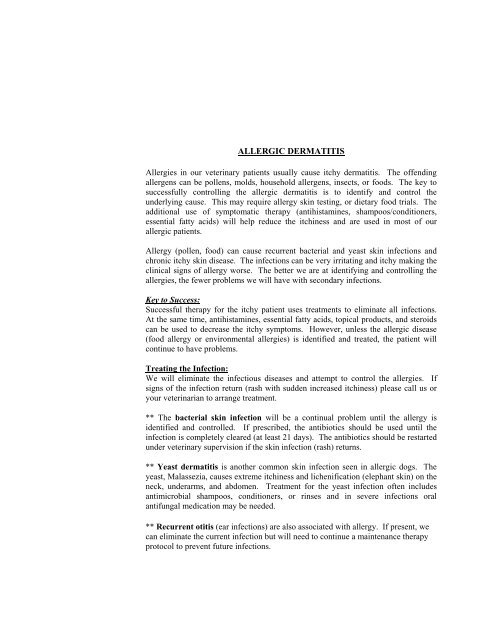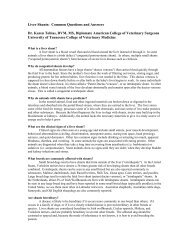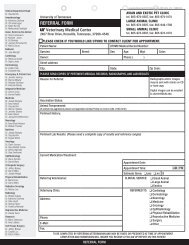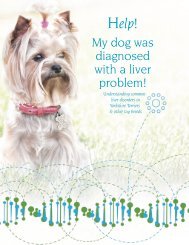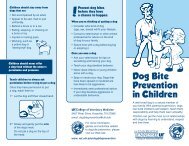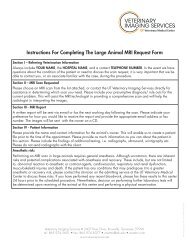ALLERGIC DERMATITIS
ALLERGIC DERMATITIS
ALLERGIC DERMATITIS
Create successful ePaper yourself
Turn your PDF publications into a flip-book with our unique Google optimized e-Paper software.
<strong>ALLERGIC</strong> <strong>DERMATITIS</strong><br />
Allergies in our veterinary patients usually cause itchy dermatitis. The offending<br />
allergens can be pollens, molds, household allergens, insects, or foods. The key to<br />
successfully controlling the allergic dermatitis is to identify and control the<br />
underlying cause. This may require allergy skin testing, or dietary food trials. The<br />
additional use of symptomatic therapy (antihistamines, shampoos/conditioners,<br />
essential fatty acids) will help reduce the itchiness and are used in most of our<br />
allergic patients.<br />
Allergy (pollen, food) can cause recurrent bacterial and yeast skin infections and<br />
chronic itchy skin disease. The infections can be very irritating and itchy making the<br />
clinical signs of allergy worse. The better we are at identifying and controlling the<br />
allergies, the fewer problems we will have with secondary infections.<br />
Key to Success:<br />
Successful therapy for the itchy patient uses treatments to eliminate all infections.<br />
At the same time, antihistamines, essential fatty acids, topical products, and steroids<br />
can be used to decrease the itchy symptoms. However, unless the allergic disease<br />
(food allergy or environmental allergies) is identified and treated, the patient will<br />
continue to have problems.<br />
Treating the Infection:<br />
We will eliminate the infectious diseases and attempt to control the allergies. If<br />
signs of the infection return (rash with sudden increased itchiness) please call us or<br />
your veterinarian to arrange treatment.<br />
** The bacterial skin infection will be a continual problem until the allergy is<br />
identified and controlled. If prescribed, the antibiotics should be used until the<br />
infection is completely cleared (at least 21 days). The antibiotics should be restarted<br />
under veterinary supervision if the skin infection (rash) returns.<br />
** Yeast dermatitis is another common skin infection seen in allergic dogs. The<br />
yeast, Malassezia, causes extreme itchiness and lichenification (elephant skin) on the<br />
neck, underarms, and abdomen. Treatment for the yeast infection often includes<br />
antimicrobial shampoos, conditioners, or rinses and in severe infections oral<br />
antifungal medication may be needed.<br />
** Recurrent otitis (ear infections) are also associated with allergy. If present, we<br />
can eliminate the current infection but will need to continue a maintenance therapy<br />
protocol to prevent future infections.
Control the Allergy:<br />
** If food allergy is a concern we may need to perform a dietary trial. To diagnose food allergy we<br />
would start a dietary trial for 10 weeks feeding only the recommended diet (no treats, table food,<br />
vitamin, chewable medication)(contact your veterinarian about heart worm preventative) for 10<br />
weeks. Watch carefully to note any changes. After 10 weeks, we would perform a dietary challenge<br />
with the old diet to confirm or rule-out diagnosis.<br />
** If environmental allergies (atopy) have been identified through allergy testing, we would<br />
consider starting hyposensitization vaccine therapy to try to decrease the immune system's allergic<br />
reactions. The vaccine and an administration schedule would be provided at the time of the allergy<br />
testing procedure or shipped to your veterinarian.<br />
** Scabies is a parasitic infection that can look exactly like pollen allergies or food allergy. If<br />
suspected, your pet will be treated with either topical dips or oral medication that will kill the mites<br />
in the skin. This disease is curable with appropriate treatment.<br />
Controlling the Itch:<br />
Controlling the allergies may require some “fine tuning” of the treatments to find the combination<br />
that works best for your pet.<br />
** Antihistamines can often help decrease the itchiness. Although not perfect, they do help reduce<br />
the itchiness with very few side effects. We may need to try several antihistamines before finding<br />
one that works well. If helpful, they can be continued indefinitely.<br />
** Essential fatty acid supplementation may be helpful to reduce the inflammation and itchiness.<br />
They have very few side effects and work with the antihistamines and steroids. If helpful, they can<br />
be continued indefinitely. If desired, give daily for 30-60 days to evaluate the response.<br />
** If necessary, use only oral steroid and try to minimize the dose. The steroids can be used to treat<br />
the severe reactions (put out the fire).<br />
** Topical therapy will help speed the resolution of the skin disease but will need to be modified as<br />
the disease resolves. A bath should be given every 3-7 days allowing the shampoo to contact the skin<br />
for 10 minutes then rinse.<br />
10/10/08


